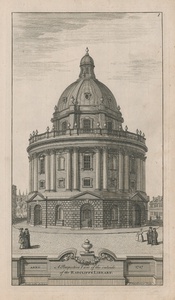| Method | Copper engraving |
| Artist | Peter Fourdrinier after James Gibbs |
| Published | [London, for the Author, MDCCXLVII (1747)] |
| Dimensions | Image 340 x 188 mm, Plate 352 x 201 mm, Sheet 417 x 258 mm |
| Notes |
The earliest and one of the rarest engravings of the Radcliffe Camera, with the Bodleian Library behind, the corner of Brasenose College on the left, All Souls' College to the right with figures in the foreground, doorway and background. Plate I from James Gibbs' Bibliotheca Radcliviana: or, a Short Description of the Radcliffe Library, at Oxford, Containing Is Several Plans, Uprights, Sections, and Ornaments, On Twenty three copper Plates, neatly engraved, With the Explanation of each Plate. Designed by James Gibbs the Radcliffe Library was constructed using funds left by the English physician, academic, and politician John Radcliffe (1650-1714). The now iconic Oxford landmark was built between 1737 and 1749 in a Baroque style. Originally intended as a separately functioning science library, it merged with the Bodleian in 1861 and is now largely a reading room. James Gibbs (1682 - 1754) was a British architect. Born in Aberdeen, Gibbs travelled extensively as a young man. In Italy he trained as an architect under Carlo Fontana. In London, he was responsible for the church of St. Mary-le-Strand, and the rebuilding of St. Martin-in-the-Fields. In Oxford, he was responsible for designing the Radcliffe Camera; the completion of the interior of Codrington Library, All Souls; and a new screen in the Hall of St John's. He was elected a member of the Society of Antiquaries in London in 1726 and fellow of the Royal Society in 1729. He published 'A Book of Architecture' (1728); 'Rules for Drawings the Several Parts of Architecture' (1732); and 'Biblioteca Radcliviana' (1747). Peter Fourdrinier (d.1750) was an eighteenth-century French engraver. Part of a refugee family who fled from Caen to Holland, Fourdrinier was a pupil of Bernard Picart in Amsterdam for six years. He moved to England in 1720 where he was employed to engrave portraits and book illustrations. He is best known for his architectural engravings, to which his mechanical style was well suited. He engraved plates for Cashel's 'Villas of the Ancients', Ware's 'Views and Elevations of Houghton House, Norfolk' (1735), Sir W. Chambers's 'Civil Architecture' (1759), Wood's 'Ruins of Palmyra' (1753) and others from the designs of Inigo Jones, W. Kent, and other architects. He also engraved the illustrations to Spenser's 'Calendarium Pastorale' (London, 1732, 8vo). Condition: Repaired small puncture in upper left of image in the sky, overall light toning to paper, and some surface dirt to edges of the sheet and several short tears not affecting the image or plate. |
| Framing | unmounted |
| Price | £750.00 |
| Stock ID | 52593 |

